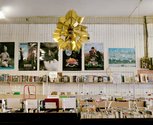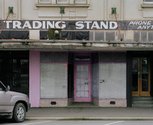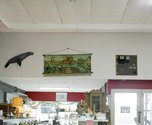John Hurrell – 2 November, 2010
The organic nature of the apparent chaos in these subtly colourful images is like a wave descending from a burst dam. However this appealing sense of visual confusion is the result of the flattening of pictorial space and an accentuation of the picture plane, not the bodily sensation the viewer would experience if they were standing in the actual shop, where in fact there is plenty of floor space not clearly detectable in the image.
When one thinks about some household possessions (like items of furniture and clothing) they often seem to improve in appearance and comfort the less new and more battered they become, and so stores selling such second-hand articles at cheap prices attract an enthusiastic client-base. Allan McDonald‘s ten photographs at Anna Miles look at the gradual disappearance of such book/clothing/bric-a-brac shops from our small towns or cities. His show scrutinises the interiors of these stores and the displays of recycled goods used to attract buyers; customers who will hopefully then love what has earlier been abandoned and give it a new home.
Because of the democratic arrangement of objects from different time periods all mixed up together - as opposed to retail stores where items usually pertain to the current historical or fashionable moment - McDonald’s images are reminiscent of displays inside rundown museums. The best of these found inside vistas have a shambolic, makeshift quality, seemingly tipping away from order and organisational structure towards overcrowding and chaos.
Yet the appearance of mayhem is deceptive. After all these places often survive for quite long periods and even become ‘institutions’, so to do that they must be organised and efficient. Within McDonald’s images it is the detailed acuity of lettered signage and pattern that fascinates, precisely focused versions of shelved, racked, stacked and piled goods - often enhanced by ordered rhythms of repeated planks within the room’s glossy white ceilings and background walls.
The organic nature of the apparent chaos in these subtly colourful images, a flowing tide of plethora invading hitherto unoccupied regions, is like a wave descending from a burst dam. However this appealing sense of visual confusion is the result of the flattening of pictorial space and an accentuation of the picture plane, not the bodily sensation the viewer would experience if they were standing in the actual shop, where in fact there is plenty of floor space not clearly detectable in the image.
That illusionary chaos spreads to create a coherent image which draws you in close. You can identify objects from different periods and see how their presence affects the ambience of each store. Different streams of history (mainly seventies onwards) mingle - but never dissolve - as they jostle for positions of visibility within the large rectangle in front of the camera.
McDonald’s affection for these fascinating storage and selling spaces is infectious, and the diversity he reveals in proprietorial sensibility and functional ‘décor’ surprising. Second-hand shops are comparatively rare in Europe (thrown out things tend to go to the tip - as worn clothing, for example, has a social stigma - or sold in markets) but here such places are accepted, loved and used by many. From his exhibition title McDonald thinks they are disappearing, but that trend might now be reversing as city centres begin to empty out, with downtown sites becoming available cheaper, as shopping malls and luxury goods venues move out to the suburbs.
John Hurrell
Recent Comments
John Hurrell
Why humour,Kim? You mean items of underwear pinned to the wall? Stuff like that?
Kim Finnarty
McDonalds' work goes from strength to strength, this is a great show full of humour, pathos and great picture making.






 Advertising in this column
Advertising in this column Two Rooms presents a program of residencies and projects
Two Rooms presents a program of residencies and projects



This Discussion has 2 comments.
Comment
Kim Finnarty, 12:01 p.m. 8 November, 2010 #
McDonalds' work goes from strength to strength, this is a great show full of humour, pathos and great picture making.
John Hurrell, 1:02 a.m. 9 November, 2010 #
Why humour,Kim? You mean items of underwear pinned to the wall? Stuff like that?
Participate
Register to Participate.
Sign in
Sign in to an existing account.